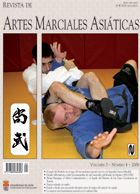Zheng Manqing: o Salão Comemorativo e o legado do Mestre das Cinco Excelências em Taiwan
DOI:
https://doi.org/10.18002/rama.v3i4.388Palavras-chave:
Artes marciais, taijiquan, tai chiResumo
O professor Zheng Manqing (1902-1975), um excelente artista e um notável discípulo de tai-chi-chuan de Yang Chengfu, emigrou para Taiwan (República da China), em 1949, depois da guerra civil chinesa entre os Guomindang e as facções maoístas. Sob o Movimento Cultural do Renascimento do Presidente da República da China Chiang Kai-Shek, Zheng desempenhou um importante papel na preservação dos “tesouros” culturais da China tradicional. Durante o período da Revolução Cultural de Mao Zedong, quando o continente estava debaixo dos olhares estrangeiros por detrás da Cortina de Bambu, Zheng contribuiu decisivamente para a introdução do tai-chi-chuan e de outros elementos da cultura chinesa no Ocidente. Zheng morreu em casa de Yonghe, Taiwan, em 1975, não sem antes cimentar a sua reputação internacional pela maestria no tai-chi-chuan e em outras artes. Recentemente, uma parte da sua antiga residência foi convertida num salão comemorativo (o Zheng Manqing Jinian Guan) pelos seus discípulos mais antigos, interessados em preservar a sua tradição marcial, as pinturas, a caligrafia e outros artefactos. Este artigo proporciona uma breve história sobre a vida de Zheng e o seu legado em Taiwan, assim como uma mostra fotográfica do Salão Comemorativo de Zheng Manqing.
Downloads
Métricas alternativas
Referências
BARNSTONE, T. y CHOU, P. (1996). The art of writing: Teachings of the Chinese masters. Boston: Shambala.
BIONDI, M. (2006). Interview with grand master Hsu Yee Chung. Publicada en la página web de la Sociedad de Estudio Shi Zhong en: http://www.37taichi.org.tw/
CHEN, W. (1929/1985). T’ai chi ch’uan ta wen: Questions and answers on t’ai chi ch’uan (traductores B. Lo y R. Smith). Berkeley, CA: North Atlantic Books.
CHENG, M. (1962). T’ai chi ch’uan: A simplified method of calisthenics for health and self defense. Taipei: Shi Zhong Taijiquan Center.
CHENG, M. (1965/1999). Master Cheng’s new method of taichi ch’uan self-cultivation (traductor M. Hennessy). Berkeley, CA: Frog, Ltd.
CHENG, M. y SMITH, R. (1967/2004). T’ai chi. Rutland, VT: Charles E. Tuttle.
CHENG, M. (1971/1981). Lao-tzu: My words are very easy to understand (traductor T. Gibbs). Berkeley, CA: North Atlantic Books.
CHENG, M. (1985). Cheng tzu’s thirteen treatises on t’ai chi ch’uan (traductores B. Lo, y M. Inn). Richmond, CA: North Atlantic Books.
CHENG, M. (1996). T’ai chi ch’uan: A simplified method of calisthenics for health and self defense. [Vídeo]. Ashville, NC: Cho San.
CHENGTZU TAI-CHI CHUAN RESEARCH ASSOCIATION, (2007). Cheng Manch’ing Ji Nien Guan Doners’ Record. Taipei, Taiwan.
DAVIS, B. (1996). In search of a unified dao: Zheng Manqing’s life and contributions to taijiquan. Journal of Asian Martial Arts, 5(2), 36-59.
DAVIS, D. y MANN, L. (1996). Conservator of the taiji classics: An interview with Benjamin Pang Jeng Lo. Journal of Asian Martial Arts, 5(4), 46-67.
FAIRCHILD, J. y LIN, G. (2007). The beginnings, growth, and development of taijiquan in Taiwan: An interview with chairman Wang Yennien. Tabei, Taiwan: Yen-nien Shanghao, publicada en el sitio web Yen-nien Daoguan.
HAYWARD, R. (1993). T’ai-chi ch’uan: Lessons with master T. T. Liang. St. Paul, MN: Shukuang Press.
JOU, T. (1981/1991). The tao of tai-chi chuan: Way to rejuvenation.Warwick, NY: Tai Chi Foundation.
LO/INN/AMACKER/FOE (1979). The essence of t’ai chi ch’uan: The literary tradition. Richmond, CA: North Atlantic Books.
MASON, R. (2001). Fifty years in the fighting arts: An interview with Robert W. Smith. Journal of Asian Martial Arts, 10(1), 36-73.
MASON, R. (2006). Revisión del libro Yang Chengfu: The essence and applications of Taijiquan. Journal of Asian Martial Arts, 15(3), 92-93.
SMITH, R. (1974/1990). Chinese boxing: Masters and methods. Berkeley, CA: North Atlantic Books.
SMITH, R. (1975). A master passes: A tribute to Cheng Man-ch’ing. Shr Jung Newsletter, 1(1), 2-7.
SMITH, R. (1995). Remembering Zheng Manqing: Some sketches from his life. Journal of Asian Martial Arts, 4(3), 46-59.
SMITH, R. (1999). Martial musings: A portrayal of martial arts in the 20th century. Erie, PA: Via Media.
WILE, D. (1985). Cheng Man-Ch’ing’s advanced t’ai-chi form instructions. Brooklyn, NY: Sweet Ch’i Press.
WILE, D. (2007). Zheng Manqing’s uncollected writings on taijiquan, qigong, and health, with new biographical notes. Milwaukee, WI: Sweet Ch’i Press.
YANG, C. (1934/2005). Yang Chengfu: The essence and applications of taijiquan (traductor L. Swaim). Berkeley, CA: North Atlantic Books.
YANG, J. (2001). Tai chi secrets of the Yang style. Boston, MA: YMAA Publication Center.
YANG, Z.D. (1988). Yang Style Taijiquan. Hong Kong: Hai Feng Publishing Co. And Beijing, China: Morning Glory Press.
YANG, Z. (1993). Yang Cheng Fu shi tai ji quan. Guangxi Province, China: Guangxi Minzu.
YU, W. y SHARP, G. (1993). Fu Zhongwen: A Yang family legend. Inside Kung-fu, Abril 1993, 44-46.
Downloads
Publicado
Como Citar
Edição
Secção
Licença
Direitos de Autor (c) 2012 Russ Mason

Este trabalho encontra-se publicado com a Licença Internacional Creative Commons Atribuição-NãoComercial-CompartilhaIgual 4.0.
Os autores que publicam nesta Revista estão de acordo com os seguintes termos:
- Os autores cedem, de forma exclusiva, os direitos de exploração (reprodução, distribuição, comunicação pública, transformação) à Universidade de Léon, podendo estabelecer, em separado, acordos adicionais para a distribuição não exclusiva da versão do artigo publicado na Revista (por exemplo: alojar no repertório institucional ou publicá-lo num livro), com o reconhecimento da publicação inicial nesta Revista.
- O trabalho encontra-se na Creative Commons Attribution-Non Commercial-Share Alike 4.0 International License. Pode-se consultar aqui o resumo e o texto legal da licença.
- Permite-se, e sugere-se, que os autores difundam electronicamente as versões pré-impressão (versão antes de ser avaliada) e pós-impressão (versão avaliada e aceite para publicação das suas obras antes da sua publicação), favorecendo a sua circulação e difusão, e com ela o possível aumento da sua citação e alcance pela comunidade académica.











